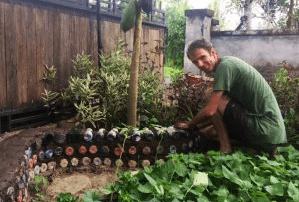 I am very excited to report that we are juuuusst now completing our first bottle construction project here in Sabangan. Working with the local youth we’ve put together a modest, yet beautiful, entrance wall and sitting area to a public picnic area in the village. The concrete is drying now, and shortly I will post the full photos. On Tuesday the major and town engineer come to visit and we discuss what more we can make with Trash in the village.
I am very excited to report that we are juuuusst now completing our first bottle construction project here in Sabangan. Working with the local youth we’ve put together a modest, yet beautiful, entrance wall and sitting area to a public picnic area in the village. The concrete is drying now, and shortly I will post the full photos. On Tuesday the major and town engineer come to visit and we discuss what more we can make with Trash in the village.
The use of PET bottles (plastic 1.5 L bottles) is an awesome building technique that was pioneered only 4 or 5 years ago by Andres Froese, a German architect, in South America. The technique has never been seen here in the Northern Philippines, and before we start building libraries and schools with it, well… as they say… seeing is believing.
The other challenge, is that the technique isn’t as relevant as it was 5 years ago in South America where PET bottles were an abundant scourge. The plastic 1.5 L bottles are here picked up and recycled. In addition, their is a bountiful supply of sand and gravel in the river town of Sabangan. They have mastered making hollow block bricks from the plentiful sand and here and they cost only 25 cents a piece. In South America the bottles are typically filled with sand or dirt.
So why bother here?
Well, there may be lots of sand and gravel, but there is also lots of trash. In addition, what drew me first and foremost to the bottle technique is that, like my collaborative mandalas, anyone can do it. You can be a grade three student or a 60 year old teacher and you can still put sand or dirt or better yet, garbage inside a bottle. It is a technique that, although labor intensive, is communal. The work can be distributed to dozens or hundreds of paticipants and everyone can participate in building a public and community building– a job that was usually reserved for only four or five specialized builders.
But best of all, these bottles CAN be filled with trash. We’ve been experimenting with a method to cut and fill the bottles, then re-seal them, in order to maximize the amount of packed trash. No special machines are needed, and suddenly, the worst trash (like batteries, and electronics, and plastics) can be put to use for the next 300 years in a public building. Yeah!
And not just any building, but a beautiful public building that was built by the community that will be very happy to use and care for that building for a long time to come.

